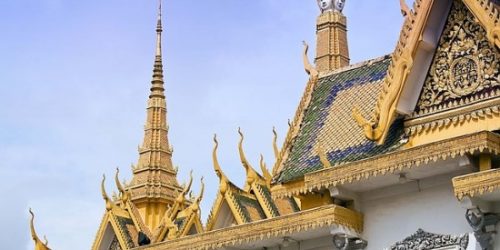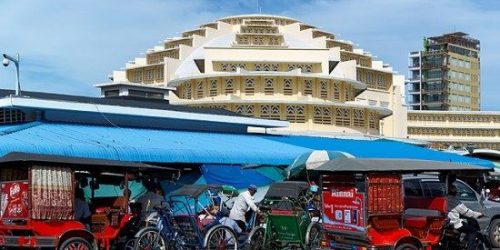Menu
Phnom Penh, Cambodia’s capital and largest city, serves as a gateway for many travelers who arrive for the first time in this exotic country. The capital of Cambodia has much to offer, from temples, palaces and markets full of history and art to breezy walks along the Mekong River and incredible lemongrass infused gastronomy. Once a jewel among France’s Asian colonies, Phnom Penh’s beauty was dulled by decades of conflict and horrors. Today, the city is full of renewed vitality and promises visitors the Asia of their dreams.
The Royal Palace of Phnom Penh is one of the most splendid architectural landmarks of the Cambodian capital. Built in 1866 by King Preah Bat Norodom, it continues to be the residence of the current royals. The complex is divided into four main buildings, on the south side is the Silver Pagoda, on the north side is the Khemarin Palace, the central building contains the Throne Hall and to the west sits the Inner Court. This entire site is located near the river, in one of the most touristic areas of Phnom Penh, making it a very accessible and comfortable visit.

The Tuol Sleng or S-21, is an essential stop for anyone who wants to explore Cambodia’s most recent past. This former secondary school turned prison during the rule of the Khmer Rouge, saw some 20,000 people tortured and annihilated. Tuol Sleng was just one of at least 150 torture and execution centers established by the Khmer Rouge. Some rooms at Tuol Sleng have been preserved as they were left when the Khmer Rouge were driven out in 1979 following a Vietnamese military incursion. The regime kept extensive records, including thousands of photographs that now line the walls of the prison.
This is the best-known of the sites known as The Killing Fields, where the Khmer Rouge regime executed over one million people between 1975 and 1979. Excavations can be seen in the area where the mass graves were located and human bones still litter the site. Today, Choeung Ek is a memorial, marked by a Buddhist stupa. The stupa has acrylic glass sides and is filled with more than 5,000 human skulls. Some of the lower levels are opened during the day so that the skulls can be seen directly, many show signs of violence.
The National Museum of Cambodia: This museum houses one of the largest collections of Khmer cultural material in the world, including sculptures, ceramics and ethnographic objects from the prehistoric, pre-Angkorian, Angkorian and post-Angkorian periods. Located north of the Royal Palace, the museum is a traditionally designed building built between 1917 and 1920, and although photos cannot be taken inside, it is allowed in the beautiful garden that welcomes visitors to the precinct.
The Psar Thmei, better known as the Central Market of Phnom Penh, is a historical building in the capital of Cambodia. The art deco style building’s main feature is the large dome of its huge central hall, which is said to be the largest in the world. In this market you can find all kinds of items, from gold and silver jewelry to clothing of all kinds. There is no better experience thane getting lost in its vast corridors.

Drive around the city of Phnom Penh on the back of a Vespa. To discover the character of the Cambodian people you must get lost in the city streets, those with little to no tourists, where locals answer with smiles and kindness. Stop for photos along the way and try some local delicacies. A unique way to touch base with locals through cultural, traditional and interactive moments.